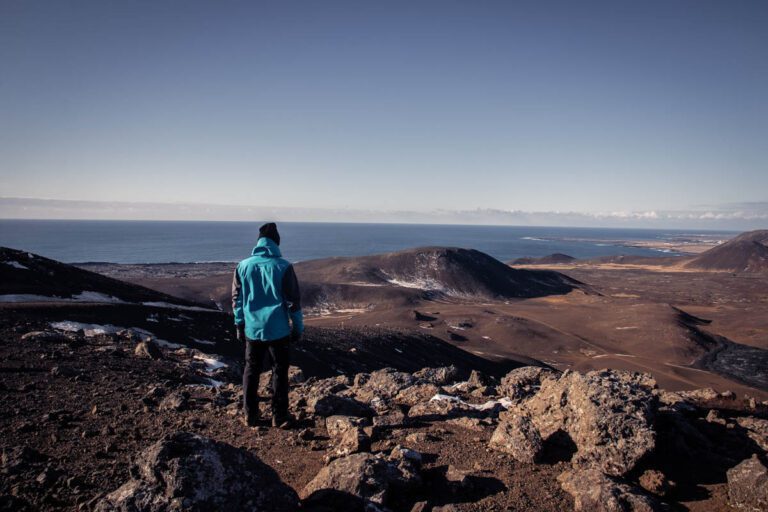Explore Búrfell Volcanic Crater in Greater Reykjavik Area
- Reykjavik
- 11 Sep 2023
Discover Burfell, a captivating symmetrical slag crater near Mt Helgafell, just 7.5 km from Hafnarfjordur and 12 km from Reykjavik. The expansive 18 km square lava field, Burfellshraun, tells a story from 7,200 years ago, branching into Hafnarfiord and Skerjafiord. Easily accessible from Heidmork, the family-friendly Burfellsgja (Burfells Trail) welcomes everyone
![Hiking to Brufell crater in Reykjavik area. [Photo credit to Yanshu Li]](https://bustravel.is/wp-content/uploads/2023/09/Hiking-to-Brufell-crater-in-Reykjavik-area-9893.jpg)
Búrfell crater is a testament to Iceland’s dynamic earth, where volcanic action plays a central role in shaping the landscape. Here, you’ll uncover the details of its formation, activity, and defining geographical characteristics.
Where is Búrfell Crater Located
Búrfell Crater is located near the picturesque Mt Helgafell, approximately 7.5 km southeast of the charming town of Hafnarfjordur and just 12 km from the vibrant city of Reykjavik, Iceland.
The symmetrical slag crater, formed around 7,200 years ago, contributed to the creation of the expansive 18 km square lava field known as Búrfellshraun. The lava flow branched into the stunning bays of Hafnarfiord and Skerjafiord, leaving a lasting geological legacy.
Easily accessible from the nearby road through the scenic recreational area Heidmork, Búrfell Crater provides an enriching and easily accessible destination for nature enthusiasts and curious explorers alike as a day excursion from Reykjavik and the capital region..
The exact GPS coordinates of Burfell crater is 64.0325138° N 21.8352266° W.

How To Get To Búrfell Crater
Getting to Búrfell Crater is a straightforward and enjoyable journey. From Hafnarfjordur, head southeast on the designated route, covering approximately 7.5 km. If you’re arriving from Reykjavik, a short 12 km drive awaits. The scenic drive takes you through the captivating Heidmork recreational area. Follow the well-marked road signs, you will be guided to the parking place to the start point of the hiking trail to the Búrfell Crater.
Starting from the parking lot, it’s a quick journey of less than an hour to ascend to the summit of Búrfell Crater. The gravel-paved hiking trail ensures a comfortable stroll, with the elevation gradually increasing as you approach the crater’s base. This gradual ascent offers an effortlessly rewarding hike, culminating in breathtaking panoramic views of the entire area from the crater’s peak.

Visiting Búrfell Crater
Búrfell Crater offers an ideal blend of geological wonder and outdoor activity, making it a must-visit for hiking enthusiasts and nature lovers. With trails tailored to different experience levels and striking panoramic views, your trip can be both invigorating and enlightening.
Hiking Trails
The Burfell Trail provides a straightforward and accessible route, typically taking around one hour one way. You can embark on this journey without the need for specialized equipment, and it’s classified as easy, catering to a wide range of fitness levels.
Once at Búrfell Crater, you’re treated to commanding views of the surrounding landscape, including Mt. Helgafell, Mt. Esjan, and vast raw landscapes created by volcanic activities in this area thousands years ago. I highly recommend you reach the crater’s edge where you can overlook the stunning vistas and truly appreciate the magnitude of this geological formation.

Stay on Marked Trail
Make sure to adhere to all posted safety notices and stay on marked trails to protect both the environment and yourself. Also, remember that Icelandic weather can be unpredictable, so always check conditions before heading out and dress appropriately.
Occasionally, the paths to the summit may be damp and slippery, scattered with stones that compromise footing. Stay vigilant about the road conditions during your ascent to ensure a safe climb. Additionally, be prepared for persistent wind conditions at the top.

What is So Special About Burfell Crater’s Formation
Búrfell’s origins trace back to its tuya formation, a type of volcano erupting beneath an ice cap or glacier. The interplay between lava and ice during its creation gives Búrfell its distinct flat-top, steep-sided structure. As part of the active Krýsuvík volcanic system, historical volcanic activity shaped the mountain and left a rich geological legacy in various igneous rock compositions.
Noteworthy features like the Búrfellsgjá lava channel and pyroclastic cone unveil the mountain’s eruptive history, while its basalt composition provides insights into the mantle’s chemistry during formation. Búrfell stands as a geological beacon, offering a unique window into the dynamic forces shaping Iceland’s captivating volcanic terrain.

Búrfell Crater in Icelandic Culture
The Búrfell crater in Iceland holds a significant place in the local culture, weaving together historical importance, and a rich tapestry of mythology and folklore. Throughout Iceland’s history, Búrfell has served as a prominent landmark, standing as a natural navigational marker and a key feature in the volcanic landscape that has shaped the country’s culture heritage.
Beyond its geological role, Búrfell is deeply intertwined with Icelandic mythology and folklore, becoming a reservoir of tales featuring trolls and elves.

Búrfell Crater’s Surroundings
Appreciating Búrfell crater means not just admiring its landscape but also understanding the need to protect its unique environment. Designated a protected natural monument in 2020, alongside Búrfellsgjá and Selgjá, these efforts aim to preserve geological formations and encourage responsible exploration. As a visitor, follow guidelines to minimize your impact.
Flora and Fauna
Búrfell crater is home to a varied biodiversity. You’ll find both common and rare plant species thriving in the fertile volcanic soil. Plus, the area supports a range of avian life, with birds nesting in the rugged terrain.
When exploring in spring, you might even encounter Icelanders’ favorite bird European golden plover (Heiðlóa) as they are the signs for summer arriving in Iceland, and see the hardy birch and willow dominating the vegetation; keep your eyes peeled for the Icelandic ptarmigan, a notable bird species often spotted in this region.



















